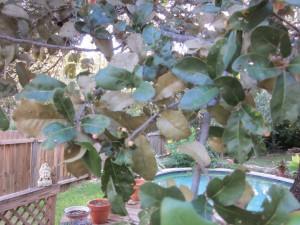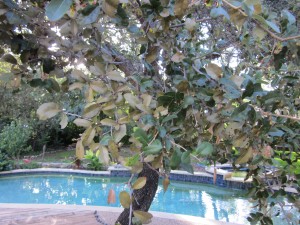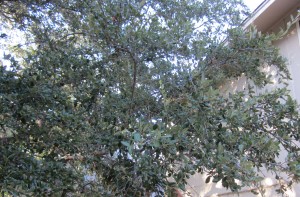
Foliage of tree that did not lose leaves.
About a week ago, I got an email in our PlantClinic box about live oak. The gentleman had read my blog post on the annual texas live oak leaf drop (March 2011). He had a very interesting question based on his observation of this tree.
Below is the email he sent:
After many years of watching my live oak trees lose their leaves every April – this year, one of them did not lose its leaves. Is this something to be concerned about? Was it last years drought that caused it? All the other live oaks in my yards have new bright green leaves after dropping the old ones. This one still has the old leaves. It does have new sprouts at the ends of the branches.
Was it something that he had to be concern about? Yes and No
Yes – This plant is acting abnormal. What could have cause this plant to not loose leaves? Is there something that is affecting the plant that is unseen. Yes, we had to be concern because of the unknown.
But…..

More of the foliage of the tree that did not lose its leaves this spring.
No – If the tree still looks okay and appears to be growing okay. New sprouts at end of branches (aka new shoots) are good. The key is to look for new bud and evidence of new growth. If the tree is growing and appears to be okay, I would not worry too much.
How to be sure? Well, the simplest approach is to compare the new growth of a typical plant close by and the affected plant. Look for a shoot and measure length of the that shoot. If all is well, the length of the shoot from a typical tree (one that dropped their leaves) and an affected tree (one that did not loose their leaves) is approximately the same, then we can conclude that both plants are still growing and seems to be fine.

Tree adjacent to the one that did not lose its leaves. This one is normal.
Let’s hope the affected tree is not showing other stress symptoms or exhibit other symptoms of concern. One of such is super heavy fruiting (lots and lots of acorn) when it is stress and might collapse the following growing season. Lets continue to care for the trees – avoid over watering and over fertilization, and keep our fingers cross that all will be well. Monitor it next spring.
Mr. J. Dyell kindly share a few photos of his trees with us.
On a different note, my diagnostician and I will be away to the Annual American Phytopathological Society meeting, held this year in Providence, Rhode Island. So the Plant Clinic will be running with a minimal staff. Please plan accordingly if you have to submit samples. Processing times will be a little delayed.


